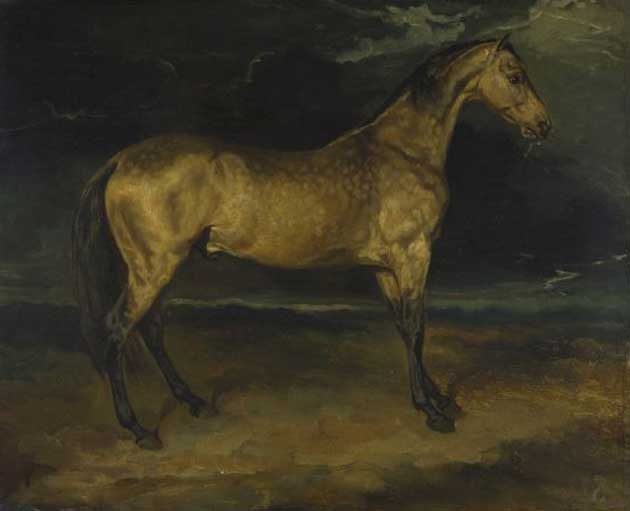Great Works: A Horse Frightened By Lightning (C1813-14), Théodore Géricault
National Gallery, London

Your support helps us to tell the story
From reproductive rights to climate change to Big Tech, The Independent is on the ground when the story is developing. Whether it's investigating the financials of Elon Musk's pro-Trump PAC or producing our latest documentary, 'The A Word', which shines a light on the American women fighting for reproductive rights, we know how important it is to parse out the facts from the messaging.
At such a critical moment in US history, we need reporters on the ground. Your donation allows us to keep sending journalists to speak to both sides of the story.
The Independent is trusted by Americans across the entire political spectrum. And unlike many other quality news outlets, we choose not to lock Americans out of our reporting and analysis with paywalls. We believe quality journalism should be available to everyone, paid for by those who can afford it.
Your support makes all the difference.Scoptophobia is the fear of being seen or watched. Iconophobia is the fear of pictures. But there is no ready word for the fear of being pictured. Perhaps there should be. The fear exists, and takes various forms. There are those who think that the camera will steal their souls. There are those who fear that any image of them may be used to get at them through black magic. There are those who simply object to having their privacy invaded.
There are also more direct causes of anxiety about being pictured. You fear what the picture itself will do to you, how it will make you look. Or you fear that it will somehow attack you. There are even pictures where, it seems, the attack is underway, and the subject knows it.
Théodore Géricault's A Horse frightened by Lightning sends mixed messages. Wild horse? Tame horse? A stallion stands on a bare shore in the middle of a storm, miles from any paddock. But in some ways, the scene follows the rules of a normal, formal thoroughbred portrait. In those portraits, the horse stands obediently still. It's presented in a perfect sideways pose. It's set off clearly from its ground and setting. It's arranged, in other words, for us to appreciate its graceful cultivation – its well-bred form, its well-trained stance. It's a horse that's posed for display, that fits happily into its showcase picture.
That is the model being referred to, at least. That's is the kind of horse-in-a-picture that this one might be – but isn't. The differences are that this is not a serenely tamed horse – there is a wild horse in it. And this picture isn't simply a homely showcase. In A Horse frightened by Lightning, there is a more uneasy relationship between the picture and its subject.
What stills the creature and holds it in this fixed position? Not discipline and self-discipline but terror. Its stasis is dramatic. It's a freeze, a flinch, a sudden defensive tightening of its body. A bolt of lightning, and the horse rears back, rocks back, rigidly tense. It's petrified, as we judge from the fear that's visible in its eyes.
That's the first mark of an animal that isn't calmly on display. What might look like steady composure is, in fact, instantaneous alarm. And this fear, this sense of abrupt arrest, gets into the rest of the scene. In several more ways, the horse appears as trapped and assailed by the picture in which it stands.
There's the lighting. The hard flash of lightning illumination exerts a grip on the horse's body, shaping it in a sharp contrast of light and shades, as against the more dispersed lighting that surrounds it.
There's the focus, which has a similar result. The horse is shown in clearly observed high-definition. The ground and background are more loosely painted. In both ways, the horse is picked out, visually held, just as it is physically held by its terror.
There's the framing. The picture's oblong is squarely aimed and centred on the horse. It crops around it in a way that feels just too tight and confining. It holds it in its sights, like a marksman's view.
There's the background. The background of a painting can come to seem less like something behind, more like a surrounding environment, a field in which the subject is embedded. Here the sky is filled with rolling clouds and flicking lightning streaks. They gather and judder around the horse's head, nagging and worrying at it.
It's the horse's fear-struck pose that sets off all these other effects. But it turns almost every aspect of this painting into an affliction that falls upon its subject. And from picture-terror, there's no escape.
About the artist
Théodore Géricault (1791-1824) was a Romantic fury – sick, driven, a self-confessed "monster", perhaps insane, suicidal (though an infection killed him). His short career is overshadowed by a single picture, 'The Raft of the Méduse', a disaster-epic filled with powerful dying bodies. He had a Michelangelesque devotion to the male physique, whether whole or dismembered, and also to the bodies of horses, whether standing magnificently or wildly charging.
Join our commenting forum
Join thought-provoking conversations, follow other Independent readers and see their replies
Comments